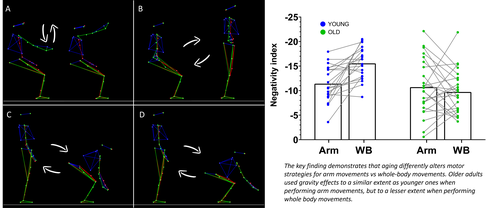
MOREL Pierre
Recommendations: 0
Review: 1
Review: 1

Comparing arm to whole-body motor control disambiguates age-related deterioration from compensation
Aging of upper-limb and whole-body movement efficiency
Recommended by Matthieu Boisgontier based on reviews by Florian Monjo, Pierre Morel, Zack van Allen and 1 anonymous reviewerThis study by Mathieu et al. (2024) builds on previous computational research showing that human arm movements use gravity to save energy and be more efficient (Berret et al., 2008; Crevecoeur et al., 2009; Gaveau et al., 2014, 2021), as well as on experimental research showing that kinematic and electromyographic markers are directly related to this energetic efficiency (Gaveau et al., 2016).
The primary objective of this study by Mathieu et al. (2024) was to compare the effect of age on movement efficiency in an upper limb task and three whole-body tasks. These two types of tasks are often studied independently in the literature. Therefore, testing them in the same study allows the generalizability of the effect of age on movement efficiency to be examined. Electromyographic and kinematic patterns were compared in younger (n = 20) and older adults (n = 24), and movement efficiency was assessed using an index based on the activity of antigravity muscles. Results suggest that the effect of age is dependent on the type of movement. Specifically, older adults used gravity less than younger adults when performing whole-body movements, whereas no such age effect was evidenced when performing arm movements. The authors interpret this effect as an adaptation of whole-body movement strategies that compensates for age-related changes in body structures and functions to stabilize postural balance.
These findings contribute to the literature on postural control and how it differs from movement control that does not include the constraint of maintaining body balance, i.e., avoiding falls. Specifically, these results suggest that our brain implements a movement strategy specific to movements that require body balance, and that the efficiency of this strategy is affected by age. Further research would help to determine whether this efficiency, although altered, remains optimal throughout the age-related decline of body systems, or whether priorities change across aging, with stability and fall avoidance becoming more valued than energetic efficiency.
References
- Berret, B., Darlot, C., Jean, F., Pozzo, T., Papaxanthis, C., & Gauthier, J. P. (2008). The inactivation principle: mathematical solutions minimizing the absolute work and biological implications for the planning of arm movements. PLoS Computational Biology, 4(10), e1000194. https://doi.org/10.1371/journal.pcbi.1000194
- Crevecoeur, F., Thonnard, J. L., & Lefèvre, P. (2009). Optimal integration of gravity in trajectory planning of vertical pointing movements. Journal of Neurophysiology, 102(2), 786–796. https://doi.org/10.1152/jn.00113.2009
- Gaveau, J., Berret, B., Angelaki, D. E., & Papaxanthis, C. (2016). Direction-dependent arm kinematics reveal optimal integration of gravity cues. eLife, 5, e16394. https://doi.org/10.7554/eLife.16394
- Gaveau, J., Grospretre, S., Berret, B., Angelaki, D. E., & Papaxanthis, C. (2021). A cross-species neural integration of gravity for motor optimization. Science Advances, 7(15), eabf7800. https://doi.org/10.1126/sciadv.abf7800
- Mathieu, R., Chambellant, F., Thomas, E., Papaxanthis, C., Hilt, P., Manckoundia, P., Mourey, F., & Gaveau J. (20024). Comparing arm to whole-body motor control disambiguates age-related deterioration from compensation. bioRxiv, version 5. Peer-reviewed and recommended by Peer Community in Health and Movement Sciences. https://doi.org/10.1101/2024.02.16.576683